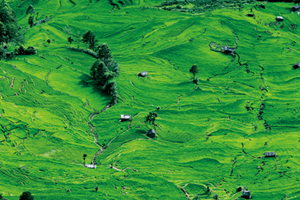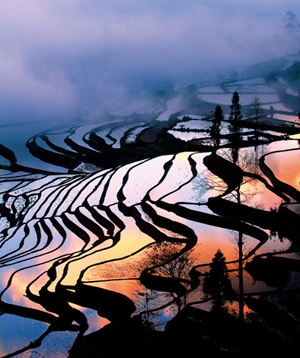Written by: Youlin Magazine Editorial Department, China
Posted on: October 29, 2013 |  | 中文
| 中文
At the 37th session of the World Heritage Committee, held in Phnom Penh, the Cambodian capital, on June 22, 2013, the Hani Terrace Fields in Honghe Prefecture of Yunna and Mount Tianshan in Xinjiang were approved for inclusion on the World Heritage List. The Honghe Hani Terrace Field became the 31st world cultural heritage site in China, and the total number of the world heritages in China reached 45, second to that of Italy.
 |
The Honghe Hani Terrace cultural landscape is located in Yuanyang County, in the Honghe Hani & Yi Autonomous Prefecture of Yunnan Province, bordering Kunming in the north, the Wenshan Zhuang & Miao Autonomous Prefecture in the east, Yuxi City in the west and Vietnam in the south. Its typical landscape includes concentrated continuous rice terraces, the forest for water resources conservation, an irrigation system and the Hani villages on which the terraces depend. Honghe Hani Terrace Fields is a fine example of a human ecosystem in the high mountain areas under subtropical monsoon climate. It reflects the perfect harmony between human beings and nature and displays the people’s great survival capability, creativity and optimism under extreme natural conditions.
The Honghe Hani Terrace Fields are a cultural farming invention created under the geographical and climatic conditions of the “four seasons in one ride and a different weather a league out” by the local peoples, Hani people in particular. It has a history of 1300 years. The terrace fields here are of large scale, stretching along the south bank of the Honghe River, covering three counties: Yuanyang, Lvchun and Jinping. Of the three, Yuanyang county has Honghe Hani Terrace Field of 190,000 mu (about 12666.7 hectares), turning the hills splendid. From the foot to the top of mountains, the terrace fields, 360,000 mu (about 24000 hectares) in area, rise step by step, 3000 steps at most, just like a man-made ladder rising up to the clouds. The largest terrace field is as large as tens of thousands of mu (more than a thousand hectares) in area, about ten kilometers long, extending from one mountain to another. The vast and continuous terraces intertwined with numerous ridges and narrow roads lead to the villages. The water runs from the mountain top to its foot all year round. A French anthropologist knelt down and exclaimed at the sight of Honghe Terrace "This is a wonder created by God!" Thanks to the introduction by photographers in the 1980s, the Honghe Hani Terrace Fields has become internationally famous, attracting people from all over the world to it.
 |
The Honghe Hani Terrace Fields, deep in the steep mountain area, are all built on mountain slopes, ranging from 15 to 75 degrees. The terrace shapes change with the landform of the mountains: large terrace fields are built on gentle slopes and small ones are built on steep slopes. Some “tiny” terrace fields are even built in the crevices between the rocks, as small as dustpans. For a single mountain slope, the number of terrace steps is 3000 and more, which is special for terraces fields in China and abroad. The Hani Terrace Fields mainly consists of three scenic spots: Bada, Laohuzui and Duoyishu. The terrace fields in Bada (mainly in 4 villages: Jingkou, Quanfuzhuang, Malizhai and Zhulu) cover 14,000 mu (about 900 hectares) of continuous fields. Those in Laohuzui (mainly in 4 villages: Mengpin, Dongpu, Amengkong and Baoshanzhai) cover 6000 mu (about 400 hectares) of continuous fields. The third in Duoyishu (mainly in 3 villages: Duoyishu, Aichun and Dawazhe) cover more than 10,000 mu (about 700 hectares) of continuous fields. These terrace fields, shadowed by boundless forest and a sea of clouds, are miraculous and magnificent.
The Honghe Hani Terrace Fields has a long history. According to the oldest historical records of Shang Shu (476?221, BC)), the Heyi, ancestors of the Hani, reclaimed terraces and grew rice on the banks of Heishui (now the Dadu River, Yalong River and Anning River Valley) in the Spring and Autumn Period and the Warring States Period (770?221, BC). Since the early Tang Dynasty, when the Hani people were settled in the Ailao Mountain areas and reclaimed terraces on a large scale, the culture of terrace field construction became the core of the Hani people. The Hani terrace fields culture, profound and unique, proves to be scientific and complete in construction and use. The Hani people, well-renowned for terrace cultivation, invented water distribution and the natural water flush fertilizer method to utilize the water resources reasonably and scientifically, and to ensure that each piece of terrace field receives enough water and fertilizer. Xu Guangqi, an agriculture scientist in the Ming Dynasty, listed the Hani Terrace Fields as one of the seven land systems in Chinese farming history and wrote a famous poem about it.
The continuous terraces fields extend from the mountain foot to the top, reaching an altitude of 2000 meters. The largest terraced fields are like a vast sea, looking as if they were crystal reflections of water. Inlaid in the mountain slopes, they look like streams flowing from the top to the bottom when seen from afar, and like ladders ascending to the clouds when seen from the side. And seen from the sky, they look magnificent and beautiful and splendid, together with the ditches and ridges, as if they were shifting scrolls of continuous paintings of nature.
Terrace fields exist in Guangxi, Guizhou and other provinces of China as well as in the Philippines, Japan, India and Nepal, but they cannot match the Honghe Hani Terrace Fields in terms of scale and splendor. Dr. Min Qingwen, an ecologist at the Institute of Geography Sciences and Natural Resources, CAS and the deputy director of Center of Natural and Cultural Heritage, thinks highly of Hani Terrace and says, "Its beauty is enchanting and it fully displays the wisdom of the Hani people for the harmony between human beings and nature. Located in the Ailao Mountain area of Honghe Hani & Yi Autonomous Prefecture, Hani Terrace Fields is not only the granary of Hani people, but also a breathtaking ink-and-wash painting. It is the representative of Chinese terrace fields and also a wonder of the world farming culture. Hani Terrace Fields, a fine farming eco-system of forest-village-teraace fields-river and streams, together with the unique culture, is unparalleled in the world. The ancient culture of the highly harmonious relations between human beings and the nature and highly harmonious relations among human beings that it contains is what we as human beings pursue in the 21st century.”
You may also like: